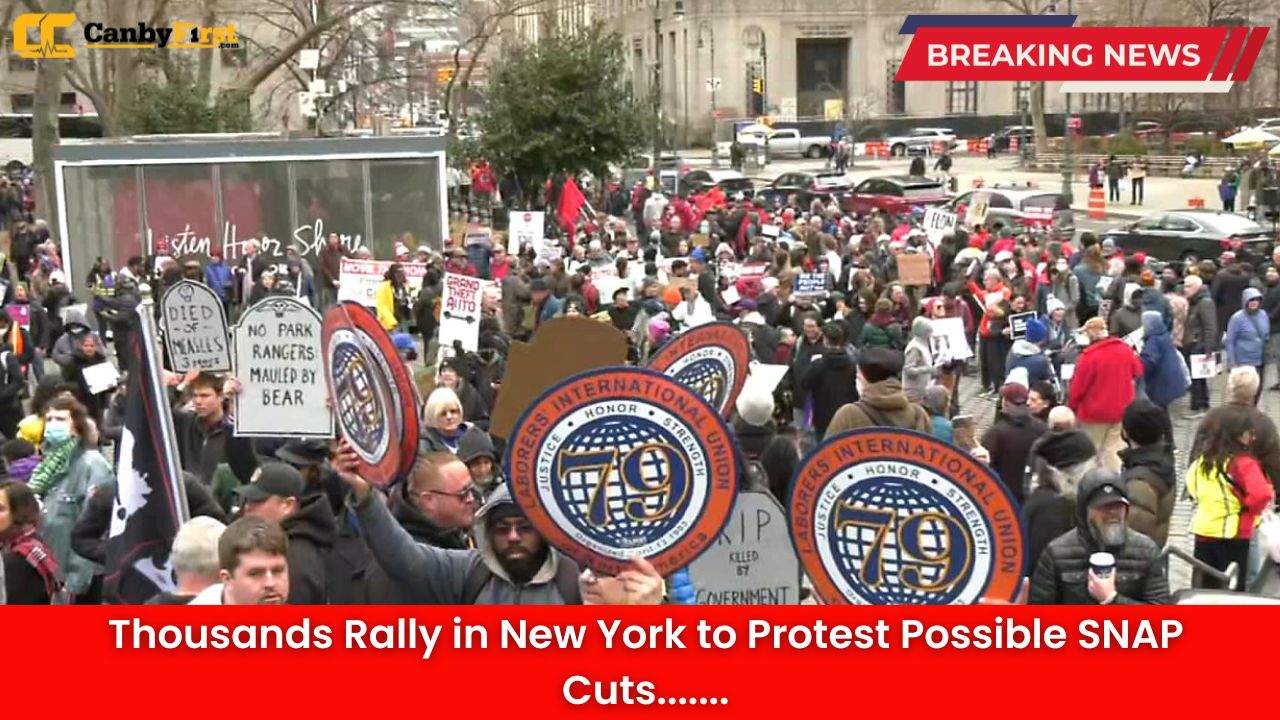New York, US: Tensions rose across New York City on Monday as thousands of residents took to the streets to oppose the federal government’s proposed cuts to the Supplemental Nutrition Assistance Program (SNAP). Protesters gathered in Union Square and marched toward City Hall, chanting slogans and carrying banners that read “Food Is a Right, Not a Privilege.”
The demonstration came after reports that Congress is debating reductions to the $127 billion SNAP budget as part of broader federal budget reforms. Advocates say such cuts could drastically affect millions of low-income families across the state who rely on food benefits to get by each month.
Impact on Vulnerable New Yorkers
According to the New York State Office of Temporary and Disability Assistance, more than 2.7 million New Yorkers currently receive SNAP benefits. Many of them are low-income families, senior citizens, students, and people with disabilities.
Also Read
Community workers warn that any reduction in funding could push thousands of already struggling residents further into food insecurity. “We’re seeing families barely managing to put food on the table,” said Maria Delgado, a social worker from Brooklyn. “Cutting SNAP now would mean choosing between buying groceries and paying rent for so many.”
Protesters Demand Accountability
Monday’s rally was organised by a coalition of nonprofit groups, food bank representatives, and grassroots activists. Demonstrators called on federal and state officials to protect the program and ensure no one goes hungry.
Chants of “Hands off SNAP!” echoed through the streets as demonstrators marched with homemade signs. Volunteers distributed free meals symbolically prepared from affordable groceries — a reminder of how far SNAP dollars can stretch when families budget carefully.
“This isn’t just about numbers,” said Jerome Foster, one of the event organisers. “It’s about real people — children, veterans, hardworking families — who depend on these benefits every single day. Without them, the consequences will be catastrophic.”
Federal Debate Fuels Local Fears
The proposed adjustments to SNAP are part of a larger federal cost-cutting package that officials say aims to “streamline social welfare programs” and reduce national spending. However, critics argue the move disproportionately targets vulnerable communities, especially in major urban centers like New York, Los Angeles, and Chicago.
Economists warn that cutting SNAP could have ripple effects beyond just food insecurity. Reduced spending on groceries could hurt local economies, particularly small neighbourhood markets that rely on SNAP transactions. “Every dollar spent on SNAP generates nearly double that in local economic activity,” said one policy analyst. “Taking away these benefits will hurt everyone, not just the recipients.”
City Leaders Weigh In
Mayor Eric Adams issued a statement expressing solidarity with those protesting and urged Washington lawmakers to reconsider the cuts. “New York City stands with our working families and vulnerable residents,” the statement read. “We will fight to keep food on every New Yorker’s table.”
Some city council members joined the march, calling the cuts “morally wrong and economically short-sighted.” They vowed to press state officials to take action if federal assistance is reduced, possibly through emergency food programs or additional city-funded support.
Food Banks Brace for a Surge
Local food pantries and community kitchens are already preparing for a potential increase in demand. Managers from City Harvest and the Food Bank for New York City said they are expanding storage and volunteer operations, anticipating that families who lose benefits will turn to them for help.
“With grocery prices still high and rent rising, families are stretched thinner than ever,” said Denise Morales, director of a Bronx food centre. “If SNAP gets cut, we’ll see lines outside our doors double overnight.”
Broader National Movement
Monday’s protest in New York was part of a coordinated nationwide action, with demonstrations also held in Philadelphia, Washington D.C., and Atlanta. Organisers say it represents a growing movement to defend food assistance programs from austerity-driven policies.
While the administration maintains that reforms are necessary to curb fraud and ensure accountability in SNAP spending, protesters argue the issue is not misuse — it’s survival. “We shouldn’t be punishing the poor for political gain,” said protest coordinator Lena Park. “Food is a human right.”
What Comes Next
Congress is expected to review the proposed SNAP reductions in the coming weeks as part of broader budget negotiations. Advocacy groups are urging lawmakers to reconsider, citing rising food costs, housing insecurity, and wage stagnation as reasons to strengthen — not weaken — support programs.
Meanwhile, community gatherings and town halls are planned across New York’s boroughs to keep pressure on policymakers. Grassroots organisers hope persistent public action will influence legislators to vote against the proposed budget cuts.
FAQ
What is SNAP?
The Supplemental Nutrition Assistance Program (SNAP) provides monthly financial assistance to low-income households for purchasing food. It is the largest anti-hunger initiative in the United States.
How many New Yorkers use SNAP benefits?
More than 2.7 million New Yorkers currently rely on SNAP, representing about one in seven residents across the state.
Why are the cuts being proposed?
Federal officials argue that reducing SNAP funding will help lower national spending and improve efficiency. Critics say the cuts are politically motivated and will worsen poverty levels.
What happens if the cuts are approved?
Many recipients could see a decrease in their monthly food benefit, forcing more families to rely on food banks, shelters, and local aid groups.
How can residents get involved?
Organisers encourage residents to contact their congressional representatives, volunteer at local food banks, and attend upcoming community rallies to voice their opposition to the cuts.












